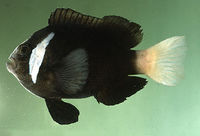Difference between revisions of "Amphiprion mccullochi"
From The Aquarium Wiki
| Line 38: | Line 38: | ||
|origin=:Lord Howe island, one of the Great Barrier Reef's southernmost islands. | |origin=:Lord Howe island, one of the Great Barrier Reef's southernmost islands. | ||
|sexing=:Males are smaller than females. | |sexing=:Males are smaller than females. | ||
| − | |tank_compatibility=:Peaceful | + | |tank_compatibility=:Peaceful or tolerant of heterospecifics. Can act very aggressively and territorial to conspecifics. In fact, it appears that their aggressive nature makes it challenging to form breeding pairs. |
|diet=:Carnivore | |diet=:Carnivore | ||
|feeding_regime=:Feed once or twice a day. | |feeding_regime=:Feed once or twice a day. | ||
| Line 51: | Line 51: | ||
== External links == | == External links == | ||
*{{FishBase |id=9208}} | *{{FishBase |id=9208}} | ||
| + | {{http://www.liveaquaria.com/general/general.cfm?general_pagesid=476 Kevin Kohen's Breeding Experience}} | ||
Revision as of 20:01, 16 November 2017
McCulloch's Clownfish
Amphiprion mccullochi
114 Litres (30 US G.)
7.6-12.7cm (3-5 ")
8.1 - 8.4
20-25.6°C (68 -78 °F)
8-12 °d
1:1 M:F
5-8 years
Family
Pomacentridae
This animal is available captive bred
| You can contribute to the Aquarium Wiki by expanding this article. Dont be shy!. |
Contents
Additional names
- McCulloch's Clownfish, Whitesnout Anemonefish
Origin
- Lord Howe island, one of the Great Barrier Reef's southernmost islands.
Sexing
- Males are smaller than females.
Tank compatibility
- Peaceful or tolerant of heterospecifics. Can act very aggressively and territorial to conspecifics. In fact, it appears that their aggressive nature makes it challenging to form breeding pairs.
Diet
- Carnivore
Feeding regime
- Feed once or twice a day.
Environment Specifics
- Does best in a rocky reef setting. Associated with the anemone Entacmaea quadricolor.
Behaviour
|
|
This section requires expansion with: Any behaviour quirks such as gulping air, or aggressiveness.. |
Identification
- An oval fish with a white caudal fin, black body and a white vertical band over the gill plate.
Pictures
External links
- Fishbase (Mirrors:
 )
)
